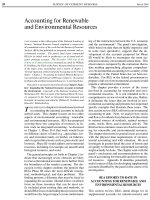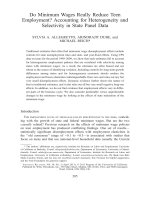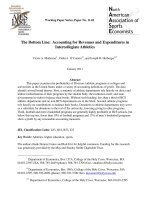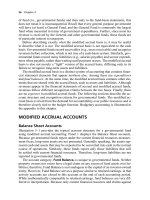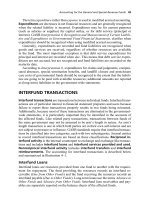[Luận văn bằng tiếng anh - GRADUATION THESIS] ACCOUNTING FOR SALARY AND SALARY DEDUCTIONS AT HA NOI – HONG HA BEER JOINT STOCK COMPANY
Bạn đang xem bản rút gọn của tài liệu. Xem và tải ngay bản đầy đủ của tài liệu tại đây (2.18 MB, 141 trang )
MINISTRY OF FINANCE
ACADEMY OF FINANCE
----🙣🕮🙡----
GRADUATION THESIS
ACCOUNTING FOR SALARY AND SALARY DEDUCTIONS
AT HA NOI – HONG HA BEER JOINT STOCK COMPANY
MENTOR: Ph.D. Thai Ba Cong
MSc. Nguyen Ba Linh
Major: Corporate Accounting
Code: 21
HANOI – 2021
1
STATEMENT OF ORIGINAL AUTHORSHIP
I hereby declare that this is the subject of my personal research. The digital
material in the thesis is truthful and has a binding origin. The result of the key
has never been published in any other work.
Ha Noi, February 22th 2022
Student
2
Table of Contents
LIST OF ABBREVIATIONS.......................................................................................7
LIST OF TABLES, DIAGRAMS AND IMAGES......................................................8
PREFACE.....................................................................................................................10
1.
The urgency of the topic:----------------------------------------------------------10
2.
The purposes of dissertation:-----------------------------------------------------11
3.
The object and scope of the dissertation:---------------------------------------11
4.
Research method:-------------------------------------------------------------------12
5.
The structure of the dissertation:------------------------------------------------12
CHAPTER 1: GENERAL THEORY ON SALARY AND SALARY
DEDUCTIONS.............................................................................................................13
1.1.
General theory of salary and salary deductions:-----------------------------13
1.1.1.
Definition of salary and payroll related compensations:--------------------13
1.1.2.
State salary system:---------------------------------------------------------------18
1.1.3.
Remuneration methods in enterprises:-----------------------------------------19
1.1.4.
Salary fund:------------------------------------------------------------------------ 21
1.1.5.
Factors affecting salary and salary deductions:------------------------------23
1.1.6. Principle of salary payment:--------------------------------------------------------28
1.1.7.
1.2.
Duties of accounting for salary and salary deductions:----------------------30
Salary deductions:------------------------------------------------------------------31
1.2.1.
Social insurance:------------------------------------------------------------------31
1.2.2.
Health insurance:-----------------------------------------------------------------33
1.2.3.
Umemployment insurance:-------------------------------------------------------34
1.2.4.
Trade union fee:------------------------------------------------------------------- 35
1.3.
Accounting for salary and salary deductions:---------------------------------35
3
1.3.1. Documents for labor accounting, salary calculation and social insurance
allowance:------------------------------------------------------------------------------------35
1.3.2. Accounting accounts used:----------------------------------------------------------36
1.3.3. Accounting entries for operations related to salary and salary deductions:- 38
1.4.
Forms of bookkeeping applied in accounting of salary and salary
deductions:-----------------------------------------------------------------------------------39
1.4.1.
“General journal” form of bookkeeping:--------------------------------------39
1.4.2.
“Journal – Ledger” form of bookkeeping:-------------------------------------42
1.4.3.
“Bookkeepping vouchers” form of bookkeeping:-----------------------------43
1.4.4.
“Voucher Journal” form of bookkeeping:-------------------------------------44
1.5.
Accounting of salary and salary deductions in terms of information
technology application:--------------------------------------------------------------------45
1.6.
Presenting information of accounting for salary and salary deductions on
financial statements:-----------------------------------------------------------------------46
CONCLUSION FOR CHAPTER 1...........................................................................47
CHAPTER 2: ACTUAL SITUATION OF ACCOUNTING FOR SALARY AND
SALARY DEDUCTIONS IN HA NOI – HONG HA BEER JOINT STOCK
COMPANY...................................................................................................................48
2.1.
2.1.1.
Overview of Ha Noi – Hong Ha Beer Joint Stock Company:--------------48
The process of formation and development of Ha Noi – Hong Ha Beer Joint
Stock Company:------------------------------------------------------------------------------48
2.1.2.
Characteristics of organization and production in Ha Noi – Hong Ha----50
Beer Joint Stock Company:----------------------------------------------------------------50
2.1.3.
Characteristics and classification of employees in Ha Noi – Hong Ha Beer
Joint Stock Company:-----------------------------------------------------------------------52
2.1.4.
Characteristics of the management apparatus organization at Ha Noi – Hong
Ha Beer Joint Stock Company:------------------------------------------------------------55
4
DIRECTOR..................................................................................................................56
GENERAL MEETING OF SHAREHOLDERS.......................................................56
Administrative Organization Department................................................................56
Finished Product Factory............................................................................................56
Electromechanical Workshop.....................................................................................56
2.1.5.
Characteristics of accounting organization in Ha Noi – Hong Ha Beer Joint
Stock Company:------------------------------------------------------------------------------59
2.2.
Actual situation of accounting for salary and salary deductions in Ha Noi –
Hong Ha Beer Joint Stock Company:--------------------------------------------------65
2.2.1.
Remuneration method and salary caculation method at the company:----65
CN xuất hàng................................................................................................................82
2.2.2.
Accounting for salary throughout Ha Noi – Hong Ha Beer Joint Stock
Company:-------------------------------------------------------------------------------------86
2.2.3. Salary deductions:------------------------------------------------------------------102
2.2.4.
Personal income tax:------------------------------------------------------------118
2.2.4.
Accounting for social insurance payments for employees:-----------------118
2.3.
General comments on the organization of accounting for salary and salary
deductions at Ha Noi – Hong Ha Beer Joint Stock Company:-------------------123
2.3.4.
Advantages:-----------------------------------------------------------------------123
2.3.2. Disadvantages:----------------------------------------------------------------------125
CONCLUSION FOR CHAPTER 2.........................................................................127
CHAPTER 3: SOME SOLUTIONS TO IMPROVE ACCOUNTING FOR
SALARY AND SALARY DEDUCTIONS AT HA NOI – HONG HA BEER
JOINT STOCK COMPANY....................................................................................128
3.1. Development orientation and principles, requirements for completing the
accounting of salary and salary deductions in Ha Noi – Hong Ha Beer Joint Stock
Company:-----------------------------------------------------------------------------------128
5
3.1.1. Development orientation:----------------------------------------------------------128
3.1.2. Principles and requirements for completing the accounting of salary and salary
deductions in the company:---------------------------------------------------------------129
3.2. Some solutions to improve the accounting for salary and salary deductions in
Ha Noi – Hong Ha Beer Joint Stock Company:------------------------------------132
3.2.1. Complete facilities and use accounting software:------------------------------132
3.2.2. Complete in terms of structure and qualifications of the accounting team: 133
3.2.3. Complete the documents and accounting books:-------------------------------133
3.2.4. Complete the accounting for salary and salary deductions:------------------134
CONCLUSION FOR CHAPTER 3.........................................................................136
CONCLUSION..........................................................................................................137
REFERENCE.............................................................................................................139
6
LIST OF ABBREVIATIONS
Abbreviation
BHTN
BHXH
BHYT
BKS
DGLcđ
DGTHS
GĐ
HSLcđ
HSTHS
JSC
KPCĐ
KPICN
KPICT
NV
PGĐ
PTP
QL
TLcđ
TNCN
TP
TTHS
VND
Full Phrase
Bảo hiểm thất nghiệp
Bảo hiểm xã hội
Bảo hiểm y tế
Ban kiểm soát
Đơn giá lương cố định
Đơn giá thưởng hiệu suất
Giám đốc
Hệ số lương cố định
Hệ số thưởng hiệu suất
Joint Stock Company
Kinh phí cơng đồn
KPI cá nhân
KPI cơng ty
Nhân viên
Phó Giám đốc
Phó Trưởng phịng
Quản lý
Tiền lương cố định
Thu nhập cá nhân
Trưởng phòng
Tiền thưởng hiệu suất
Viet Nam Dong
7
LIST OF TABLES, DIAGRAMS AND IMAGES
Diagram 1.1. T-accounts of accounting for salary
Diagram 1.2. T-accounts of accounting for salary deductions
Diagram 1.3. The order of recording “General Journal” form of bookkeeping
Table 1.1. A part of Balance Sheet in the Financial Statement
Table 2.1. Labor summary of Ha Noi - Hong Ha Beer Joint Stock Company in
the period of 2018-2020
Table 2.2. Timesheet of Financial – Accounting Department
Table 2.3. Timesheet of Planning – Material Department
Table 2.4. Table of salary payment of Financial – Accounting Department
Table 2.5. Table of salary payment of Executive Board
Table 2.6. Table of salary payment of Planning – Material Department
Table 2.7: Fixed salary scale, performance bonus printed in Ha Noi – Hong Ha
Beer Joint Stock Company regulations
Table 2.8. Table of salary payment of Ha Noi – Hong Ha Beer JSC
Table 2.9. General Journal of Ha Noi – Hong Ha Beer JSC
Table 2.10. Detailed book of Account 334 from 01/11/2020 to 31/12/2020
Table 2.11. Ledger of Account 334 from 01/11/2020 to 31/12/2020
Table 2.12. Detailed book of Account 338 from 01/11/2020 to 31/12/2020
8
Table 2.13. Ledger of Account 338 from 01/11/2020 to 31/12/2020
Diagram 2.1: Management structure of Ha Noi – Hong Ha Beer Joint Stock
Company
Diagram 2.2: Structure of accounting apparatus in Ha Noi – Hong Ha Beer Joint
Stock Company
Diagram 2.3. Process of recording salary and salary deductions
Image 2.1. Salary and salary deductions caculation on Microsoft Excel software
Image 2.2. GREEN EFFECT accouting software interface
Image 2.3. List of accounts on EFFECT accounting software
Image 2.4. Accounting for salary payment on EFFECT accounting software
Image 2.5. Salary performance on EFFECT accounting software
Image 2.6. Payment order
Image 2.7. Accounting for salary deductions on EFFECT accounting software
Image 2.8. Cash received note
Image 2.9. Tax received note
Image 2.10. Accountanting for payment of sick and maternity benefits
9
PREFACE
1. The urgency of the topic:
For production and business enterprises, wages are a significant part of
production costs. If enterprises apply a reasonable salary regime, it will create a
driving force to increase labor productivity... Salary acts as an economic lever
that directly affect employees. Labor costs account for a relatively large
proportion of the total production costs of enterprises. Therefore, businesses
need to strengthen labor management, accounting for salaries and deductions
according to salary needs to be accurate and timely to ensure the interests of
employees, creating conditions to increase labor productivity, save labor costs,
promote production activities and lower product costs.
For employees, salary is extremely important because this is the main source
of income to help them ensure a living for themselves and their families.
Therefore, wages can be a motivating force for employees to increase labor
productivity if they are paid according to their contribution, but it can also
reduce labor productivity, making the production process slow down, is
inefficient if salary is lower than the labor power of employees. Therefore, the
construction and selection of reasonable salary forms so that the salary is both an
income for employees to meet their material and spiritual needs, and at the same
time makes salary become the driving force for the development of employees
and workers. Motivating employees to work better, with a sense of responsibility
for their work is really a necessary job.
10
Realizing the importance of the above issue, I chose the topic "Salary
accounting and payroll related compensations in Ha Noi - Hong Ha Beer Joint
Stock Company" to study the theory of salary and payroll related compensations
and practical application in Ha Noi - Hong Ha Beer Joint Stock Company.
During my internship and graduation thesis at the company, I had the
opportunity and conditions to learn and research the theory of salary and payroll
related compensations and the practical application of them in the Company. It
has helped me a lot in consolidating and expanding the knowledge learned in
school that I have not had the opportunity to put into practice.
2. The purposes of dissertation:
- Learn about the theoretical basis of salary and payroll related
compensations at the enterprise.
- Research and analyze the current situation of salary and payroll related
compensations in Ha Noi - Hong Ha Beer Joint Stock Company.
- Proposing some measures to improve the accounting of salary and payroll
related compensations Ha Noi - Hong Ha Beer Joint Stock Company.
3. The object and scope of the dissertation:
- Reasearch object: Accounting for salary and salary deductions at Ha Noi –
Hong Ha Beer Joint Stock Company.
- Research scope: Accounting for salary and salary deductions at Ha Noi –
Hong Ha Beer Joint Stock Company from 18/10/2021 to 18/02/2022.
11
4. Research method:
My thesis is researched based on the method of analyzing theoretical and
practical problems in a scientific and logical manner, combining inference with
induction, between text and tables and diagrams.
5. The structure of the dissertation:
Chapter 1: General theory on salary and salary deductions in enterprises.
Chapter 2: Actual situation of Accounting for salary and salary deductions at
Ha Noi – Hong Ha Beer Joint Stock Company.
Chapter 3: Some solutions to improve accounting for salary and salary
deductions at Ha Noi – Hong Ha Beer Joint Stock Company.
12
CHAPTER 1: GENERAL THEORY ON SALARY AND SALARY
DEDUCTIONS
1.1.
General theory of salary and salary deductions:
1.1.1. Definition of salary and payroll related compensations:
1.1.1.1. Labour and the meaning of labour management:
Definition of labour:
Labour is the use of physical or mental strength through labor tools to
improve nature for the spiritual purpose of serving people.
It can be said that labour is the decisive factor for all economic activities.
Especially, high-productivity, quality and effectiveness of labor are the decisive
factors for the development of the country, society, family and each worker.
Characteristics of labour:
Labour is the first and necessary factor for the development of a society.
Labour is a purposeful and conscious activity of people to create products to
serve the needs of life. Therefore, labor is the most characteristic and creative
activity of human and only through labour can the society change in a positive
direction.
Labour is the decisive factor in the production process. Labour creates
material products for human life. It is not natural that everything is available for
us to use, but there is a labor process to create them.
Labour is also a factor that determines the wealth of a society. Each particular
labor creates a certain type of use-value. The more specific types of labour, the
more different types of use-values are created. Concrete labour constitutes the
13
social division of labor. Along with the development of science and technology,
specific forms of labor are increasingly diversified and abundant, reflecting the
development level of the social division of labour.
Meaning of labour:
Labour has extremely important and great significance in all aspects of life,
economy and society.
Labour creates material resources to support each person, each family and
the whole society.
Labour is a legitimate source of income, helping to stabilize people's lives.
Labour has contributed to the history of human social development over
many generations.
Labour is a legitimate source of income, helping to stabilize people's lives.
Meaning of labour management:
Labor management includes many issues, but mainly shown in the following
contents:
- Management of the number of employees: is the management of the
number of employees in terms of gender, age, expertise...
- Labor quality management: is to manage all aspects of the capacity of
each group of workers in the production process to create products (such as labor
power, labor level, skill - technique, consciousness)
Therefore, only on the basis of a certain quantity and quality of labor will the
organization, arrangement and arrangement of labor be reasonable, making the
production process of the enterprise go smoothly and effectively. high. On the
contrary, not paying due attention to labor management will lead to stagnant and
14
inefficient production capacity of enterprises. At the same time, good labor
management is the basis for evaluating remuneration for each employee in a
correct and fair manner. The right and fair remuneration regime will stimulate all
employees in the enterprise to work creatively, improve technical skills, save
raw materials, increase labor productivity, and contribute to increasing profits.
1.1.1.2. Definition, nature and meaning of salary and salary deduction:
Salary:
Salary is remuneration or income that can be expressed in monetary terms
and fixed by agreement between the employer and the employee, or by National
Law or regulation by the employer that the salary has to be paid for the
employee under an employment contract for work performed or to be performed,
or services performed or to be performed.
Salary is paid to employees on a regular basis, usually monthly. Economic
organizations, businesses and employers pay for workers according to the
quantity and quality of work they have contributed. Salary will vary between
different occupations because workers provide different values of labor power.
Salary also depends on where the worker is hired and the demand. If the demand
for labor is high, salary will tend to increase. In contrast, salary will tend to
decrease in areas where there is a surplus of labor. The salary of workers in some
countries also differ if their gender and race are different. Salary is typically
determined by comparing market pay rates for people performing similar work
in similar industries in the same region. Salary is also determined by leveling the
pay rates and salary ranges established by an individual employer. Salary is also
15
affected by the number of people available to perform the specific job in the
employer's employment locale.
The nature salaries is the price of labor power formed on the basis of the
value of labor power through an agreement between the person with the labor
capacity and the employer and adjusted by economic laws such as the law of
supply and demand, the law of value, etc.
According to the Marxist-Leninist point of view, salary is a part of national
income expressed in money that workers receive to compensate for their labor,
depending on the quantity and quality of the workers. Thus, salary is a part of
newly created value that is distributed to workers in order to reproduce their
labor power because workers in the process of participating in production must
consume the most amount of labor power determined and must then be offset by
the means of consumption.
Salary is the basic factor that determines the increase or decrease in income
of employees and the material standard of living of salaried employees in
enterprises. Therefore, it is necessary to pay fair and accurate wages, ensure the
interests of employees, to create stimulation and proper attention of employees to
the final results of the enterprise. It can be said that accurate and correct salary
accounting is an important economic lever that arouses positive factors in each
person, promoting the talents, initiatives, sense of responsibility and enthusiasm
of employees… constitutes an important driving force of economic development.
On the other hand, salary is one of the costs of the business, accounting for
a significant proportion. The goal of the enterprise is to minimize costs and
maximize profits, but besides that, it must also pay attention to the interests of
16
employees. So how to both ensure the interests of employees and ensure the
interests of businesses. That is the dilemma of every business. Therefore,
accounting for wages and salary deductions not only has the meaning of
promoting the positivity, initiative and creativity of employees, but also helps
managers to effectively use the salary fund. ie rationalizing costs to help
businesses become profitable. Provide complete and accurate information about
the salary of the enterprise so that the enterprise can make timely and reasonable
adjustments for the next revenue periods.
Salary deductions:
Salary deductions are deductions according to salary and expenses that the
employee and the employer must jointly make to ensure the stability of the
employee's life and maintain the activities in the enterprise. Currently in
Vietnam, the most commonly applied salary deductions are:
- Social insurance: is the amount of money that enterprises and employees
pay to compensate a part of income for employees in case of loss of working
capacity such as sickness, accident, maternity.
- Health insurance: The amount that the employer and the employee pay to
the insurance agency to support the cost of medical examination and treatment
when sick or ill.
- Unemployment insurance: An amount of money that businesses and
employees pay to provide temporary financial support when losing their jobs but
must meet all conditions as prescribed by law.
- Trade union fee: is the money that only enterprises pay to achieve targets
for the organization's activities.
17
1.1.2. State salary system:
Accordingly, salaries, allowances and operation fees of cadres, civil
servants, public employees and employees shall comply with the provisions of
Clauses 1, 2, 3, 4 and 7, Article 1 of Circular 04/2019/TT-BNV calculated
according to the current salary coefficient and allowances specified in the
documents of competent agencies of the Party and State on the salary regime for
cadres, civil servants, public employees and the armed forces. ..., the base salary
is specified in Decree 38/2019/ND-CP dated May 9, 2019, specifically as
follows:
How to calculate salary:
Salary in 2021 = Basic salary 1,490,000 VND / month x Current salary
coefficient
How to calculate allowances:
- For allowances calculated according to base salary:
Allowance level in 2021 = Basic salary 1,490,000 VND / month x Current
allowance coefficient
- For allowances calculated according to % of current salary plus
allowances for leadership positions, over-frame allowances (if any):
Allowance level in 2021 = Salary in 2021 + Leadership allowance in 2021 (if
any) + Seniority allowance in 2021 (if any) x Percentage of allowances as
prescribed
- For allowances specified at a specific rate, they will remain the same
according to current regulations.
18
How to calculate reserve difference factor (if any):
Amount of reserve margin in 2021 = Basic salary VND 1,490,000 / month x
Operating fee coefficient as prescribed
1.1.3. Remuneration methods in enterprises:
1.1.3.1. Time-based schemes:
Time-based scheme is a form of paying employees according to working
time, salary level (title) and salary level (salary coefficient). This form is mainly
applied to indirect labor, stable labor or direct labor without product norms.
In enterprises, the form of time-based salary payment is applied to people
doing office work such as administration, labor organization, statistics, finance accounting. Time-based payment is a form of salary payment to employees
based on the actual working time, occupation, professional and technical
qualifications of the employee.
Depending on the industry and the specific nature of the job, different
salaries apply. Professional and technical qualifications are divided into many
salary levels, each salary grade has a certain salary level, which is the basis for
salary payment, which can be divided over time.
Time salary is a way of calculating wages for employees according to the
time worked. It can be by month, by day, by hour.
In fact, there are two ways to calculate salary in business:
19
Method 1:
Monthly salary = Salary + (allowance (if any) / standard working days per
month) * actual number of working days
Under this salary calculation, the monthly salary is usually a fixed number,
which is reduced only when the employee takes unpaid leave.
Monthly salary = Salary - (salary / standard working day in a month) * number
of days of unpaid leave
With this form of payment, employees do not worry about monthly income.
Because the amount deducted for each day of unpaid work is fixed. How many
days off, how much money they deduct. If there is no change in salary and vice
versa, if working full days as prescribed, full salary will be paid.
The standard working day in a month is the number of working days in the
month according to regulations. Holidays are not included.
Method 2:
Monthly salary = Salary + (Allowance / 26) * actual working days
(Businesses self-stipulate 26 or 24 working days)
Under this salary calculation, the monthly salary is no longer a fixed
number because the standard working days are different each month. Because
there are months with 28, 30, 31 days.
20

